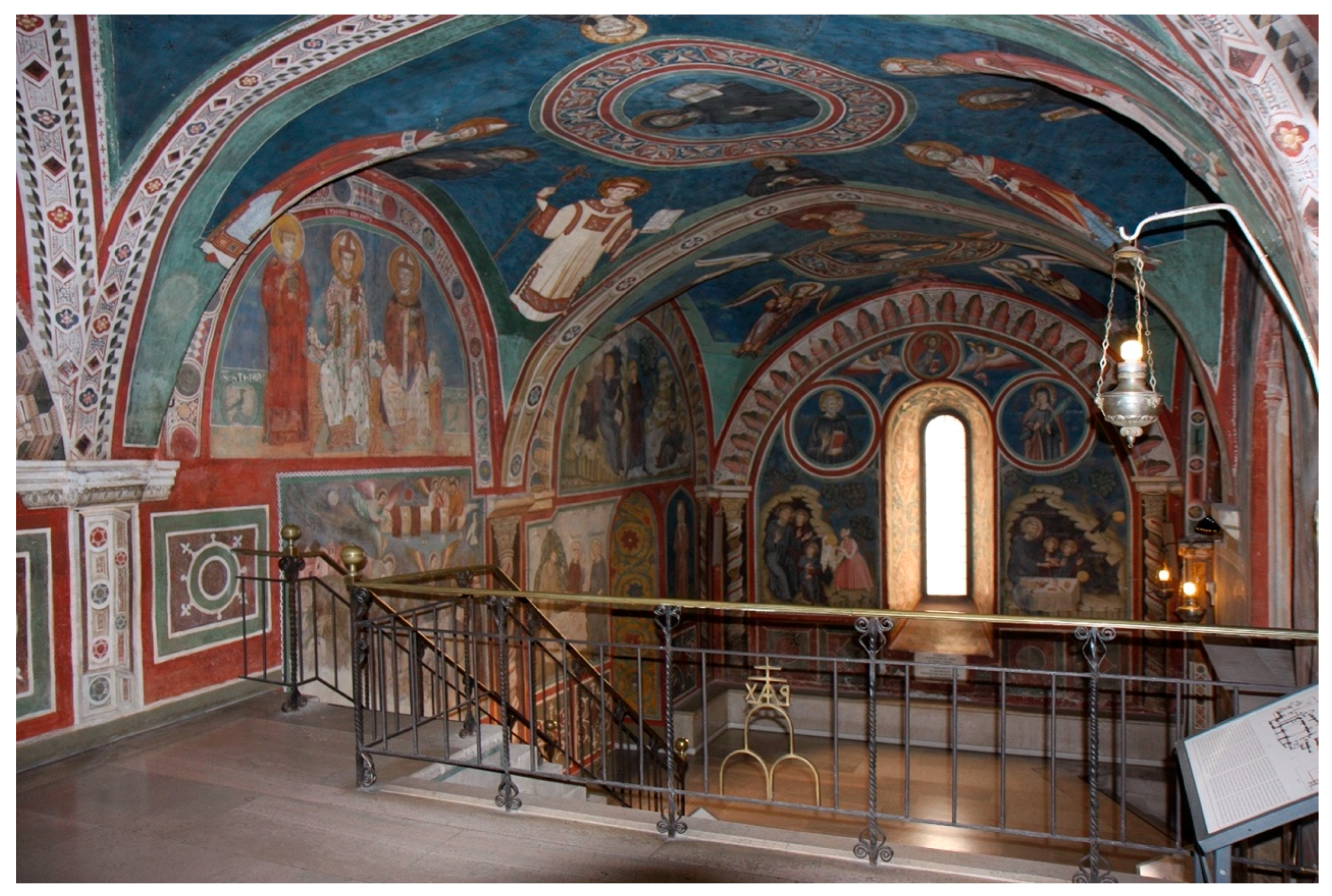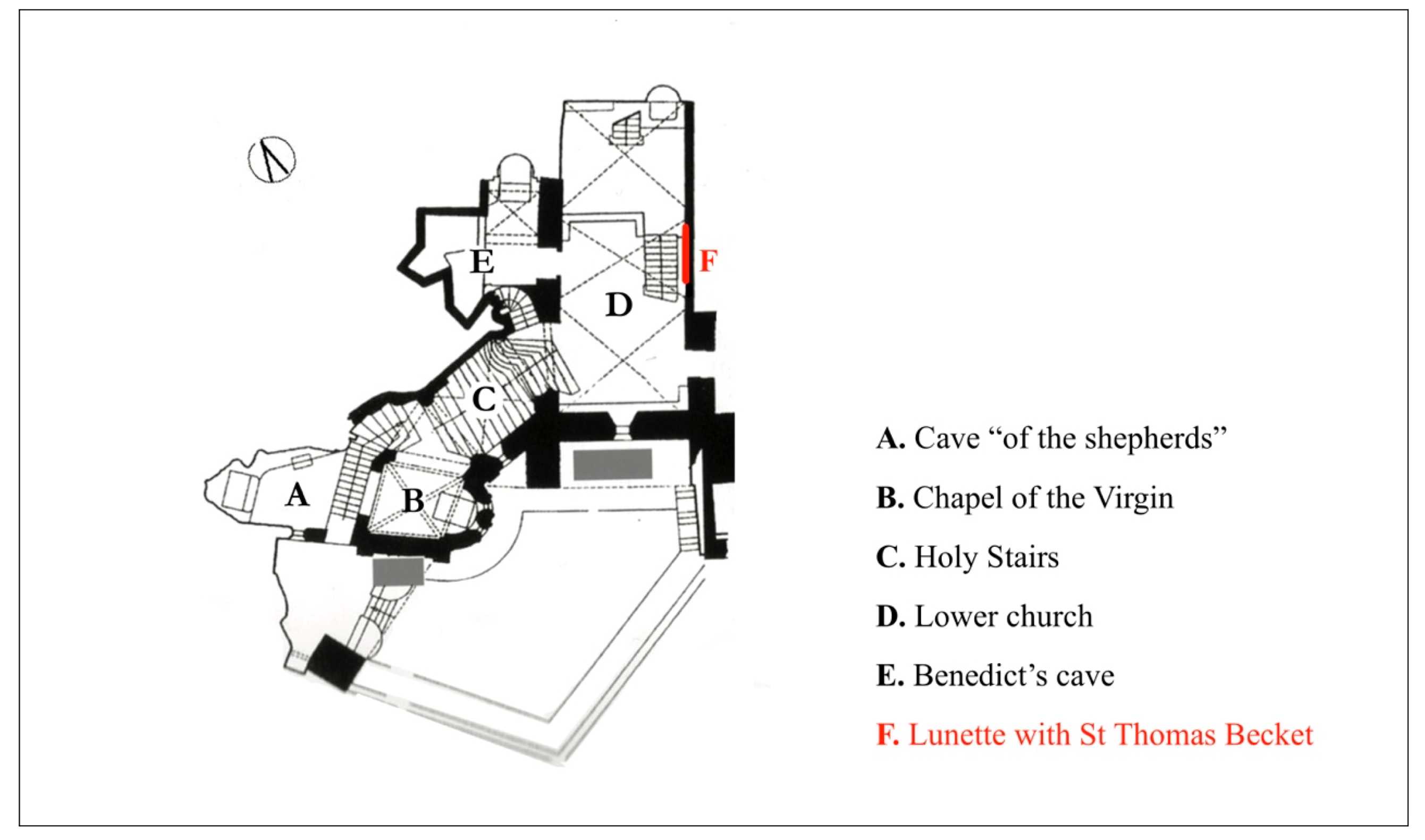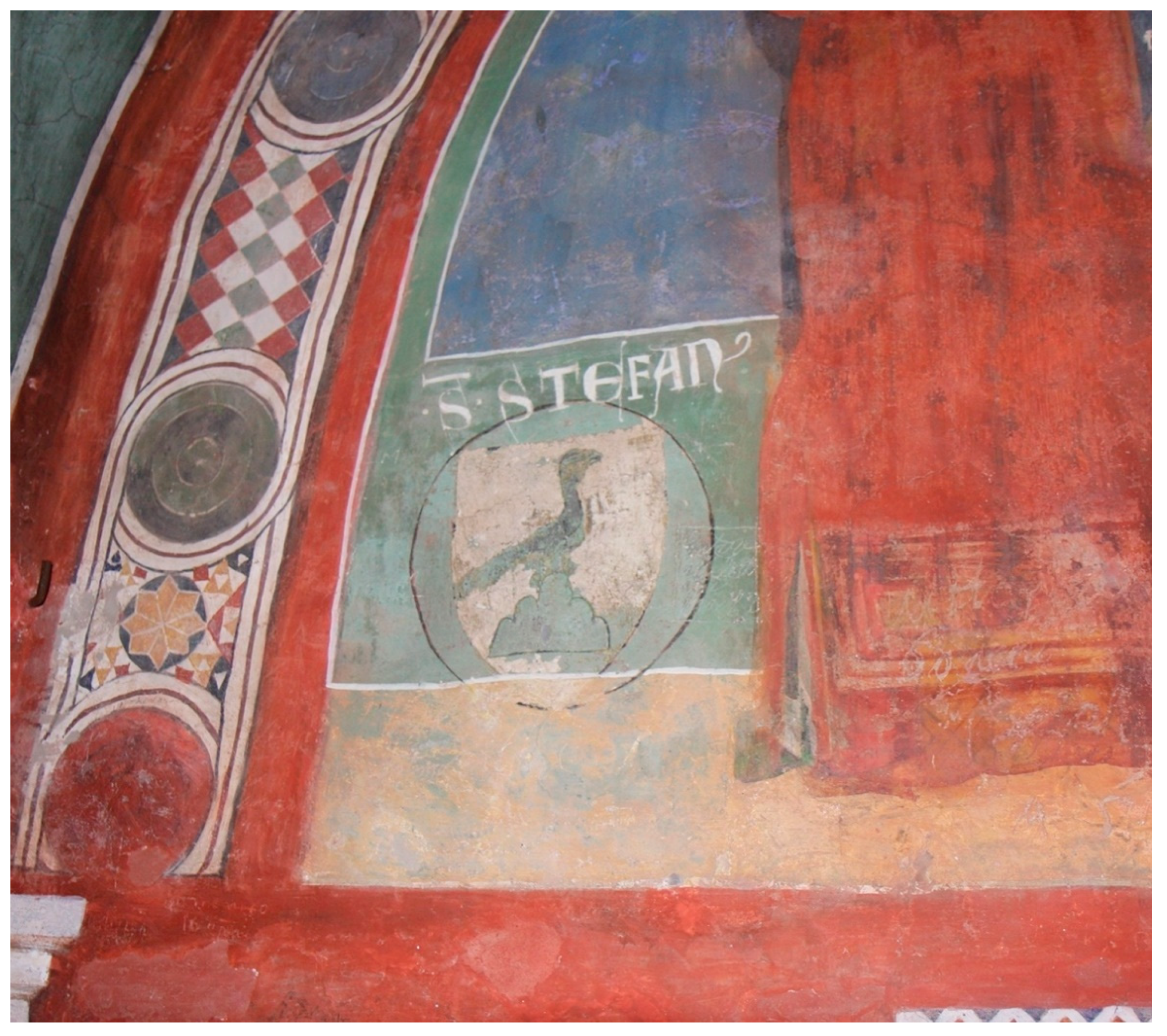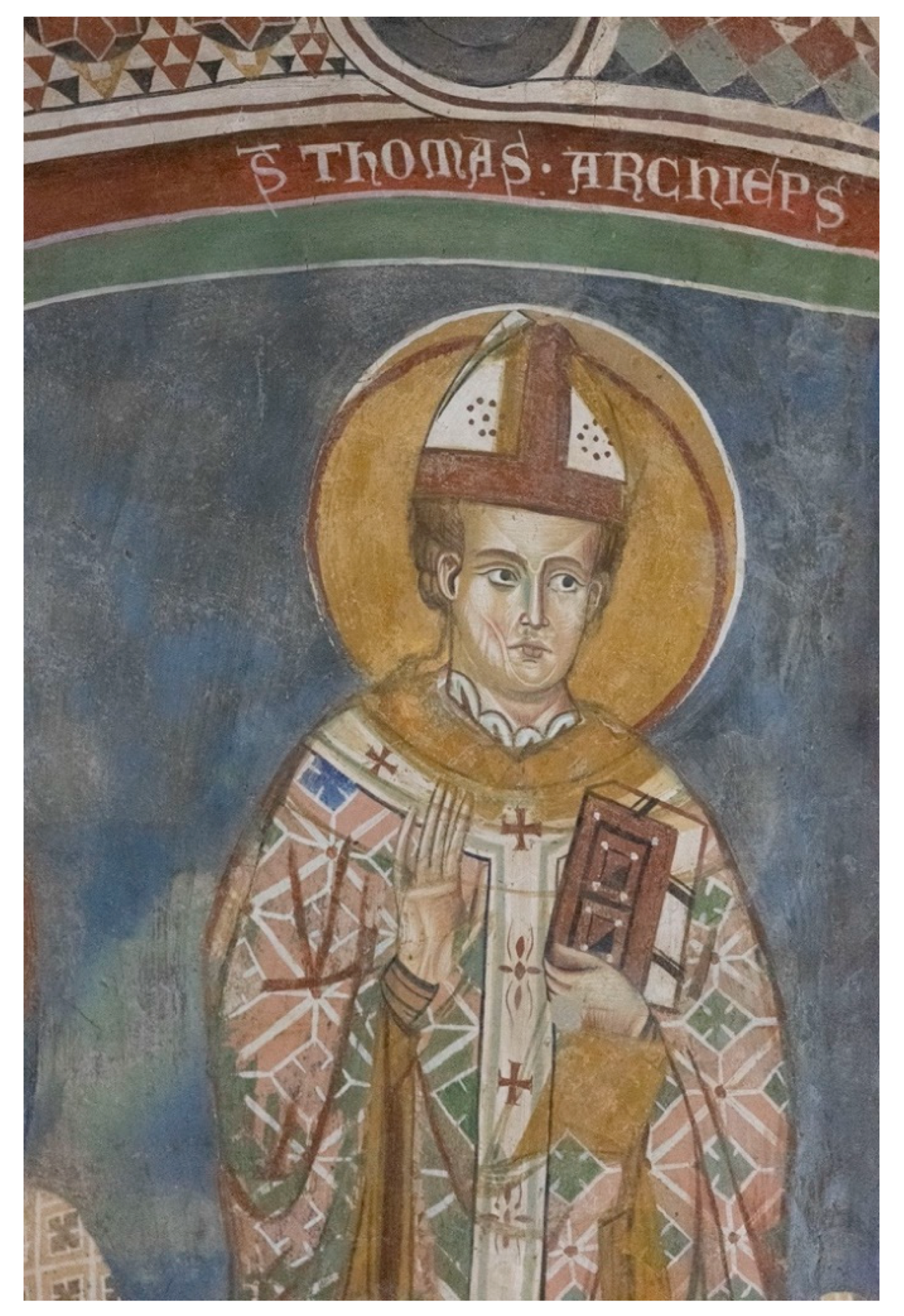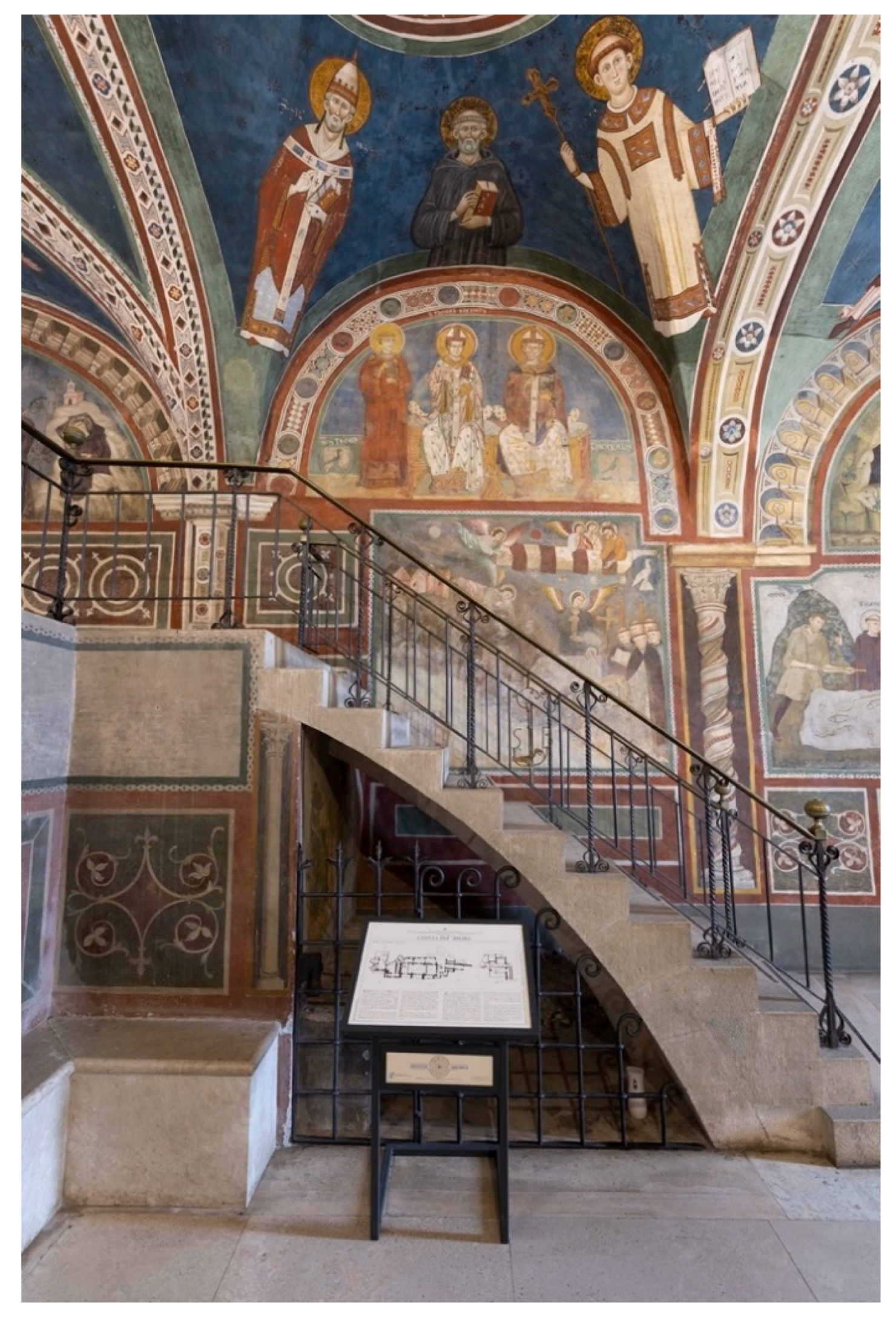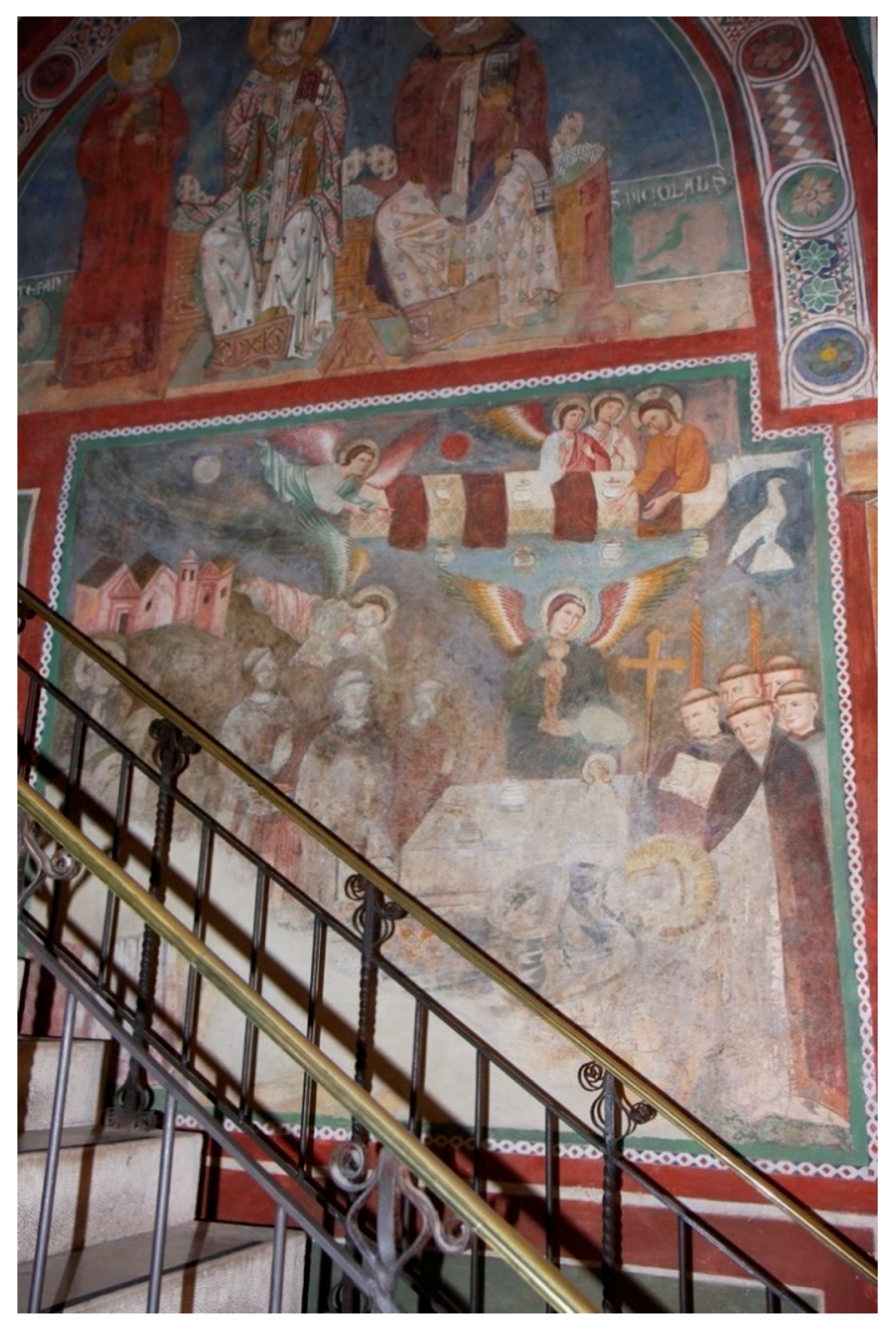1. Introduction
At the beginning of the sixth century, St. Benedict of Norcia, fleeing Rome and worldly temptations, sought refuge in Subiaco in the Aniene valley, as Gregory the Great recounts in the second book of his Dialogues.
1 Benedict’s presence encouraged the development of cenobitic life in the valley with a series of no less than thirteen monasteries founded directly by the saint (
Pani Ermini 1981;
Fiore Cavaliere 1994, pp. 13–24). Among these, already at the end of the tenth century, the monastery of Santa Scolastica stood out for its importance and became the centre of a vast territory (
Cerone 2015, pp. 39–43). From the end of the twelfth century, however, it was the community established at the Sacro Speco that took up Benedict of Norcia’s spiritual inheritance, thanks in part to the inspiring presence of Benedict’s cave, which was a constant reminder of the sacrifices required by regular life.
The sanctuary of the Sacro Speco, where the lunette with St. Thomas Becket is painted (
Figure 1), is linked to veneration of the cave on Mount Taleo where for three years St. Benedict retired as a hermit, before abandoning his solitary existence for a cenobitic lifestyle, trying out the rule that he later established in Montecassino (
Figure 2). None of the thirteen original monastic communities took up residence there, but the memory of the cave remained intact over the following centuries and the site soon became a destination for pilgrimage and attracted the euergetism of the popes.
Thus it was that, starting from the ninth century, a series of initiatives led to the monumentalization of the cave.
2 The first intervention, with Pope Leo IV (847–855), involved the construction of some altars, one in honour of the saint and his sister Scholastica and the other of Pope St. Silvester (
Carucci and Morghen 1991, p. 151). Since at the time there was still no stable community at the site and the system of natural caves was sporadically home to hermits, it is unlikely that the altars were located inside a masonry building; instead, they must have been inside the caves themselves: that in which Benedict had lived, but also that below, known as the cave “of the shepherds”, to which the local people flocked to hear him speak (
Gregorius Magnus 1847, cols. 128–32).
We must await the eleventh century for further news of the Speco. Under the rule of the Abbots Umbertus (1051–1060) and Iohannes V (1060–1121), a first attempt was made to create an alternative monastic centre to Santa Scolastica, though still under its control. According to the Chronicon, Umbertus built a “beautiful church and a covered crypt”, of which no trace remains today (
Carucci and Morghen 1991, p. 156). Nothing prevents us from hypothesizing that this was an oratory, small in size but worthy of hosting the prayers of illustrious guests—such as Pope Gregory VII (1073–1085) and the Abbot of Montecassino, Desiderius—who often travelled to visit the holy cave (
Carucci and Morghen 1991, p. 163).
The sources attribute to Iohannes V the first authorization to settle at the Sacro Speco, according to a small group of friars under the guidance of the monk Palumbo (
Carucci and Morghen 1991, p. 167). This same abbot was also responsible for the arrangement of the key areas of the sanctuary, starting with the Holy Stairs, mentioned in the sources for the first time, which served to ease the path of the faithful as they ascended towards the hermitage (
Carucci and Morghen 1991, pp. 173, 176). Iohannes V also renovated the early medieval altars, ruined by damp, and built new ones; the chronicles associate his name, for example, with an altar in honour of the Virgin, as well as a chapel dedicated to St. Romanus, the monk who had taken care of St. Benedict and dressed him in the monastic habit. It is impossible today to define the nature of this place, but we can perhaps guess at its location: immediately above the saint’s cave, to commemorate the point from which Romanus lowered the basket with bread for Benedict, as Gregory the Great narrates (
Gregorius Magnus 1847, col. 130).
The narrative of the sources thus attests that during the eleventh century a rocky devotional route had now become consolidated, leading upwards to the series of altars in honour of the Virgin, of Silvester, then of St. Romanus and finally to the veneration of the cave. No material traces remain of this primitive arrangement except the fresco with the Virgin and St. Silvester in the Grotta dei Pastori (“Cave of the Shepherds”), dating to between the ninth and tenth centuries (
Cristiani Testi 1982, p. 95;
Matthiae and Andaloro 1987, p. 196). The refoundation of the sanctuary in the thirteenth century erased the earlier traces and gave the sanctuary the appearance it still partially retains today.
2. The Thirteenth-Century Refoundation
The papacy of Pope Innocent III (1198–1216) marks the start of a long phase in which new buildings were constructed next to the caves in a gradual process of monumentalization that lasted until the end of the thirteenth century. The worksite was divided into two distinct phases: the first at the beginning of the century, ending at the time of Gregory IX (1227–1241); the second—more significant—in the second half of the thirteenth century, sealed by the fresco painting of the lower church with the Stories of Benedict by Magister Conxolus, executed at the end of the thirteenth or perhaps the very beginning of the fourteenth century (
Giovannoni 1904, pp. 381–88;
Righetti Tosti-Croce 1982, pp. 78–86). To correctly contextualize the lunette with St. Thomas Becket both phases should be examined because this was one of the first paintings to decorate the sanctuary, but in the second half of the century it was also significantly restored and even incorporated into the new decorative programme.
In the year 1200, the chronicles record the news of a prior of the Sacro Speco for the first time and thus attest to the presence of a stable monastic community.
3 Thanks to the support of Innocent III, this group of brothers gained financial independence from the larger monastery of Santa Scolastica with which, however, they continued to share an abbot. The series of letters, dated between 1202 and 1203, that the pope addressed to the monks of the Speco, show the admiration for the small brotherhood that followed the rule of Benedict in an exemplary manner, in contrast to the corrupt “twin” community of Santa Scolastica, severely rebuked in other missives (
De Prosperis 2008, pp. 18–24). However, it was not just the religious aspects that attracted the attention of Innocent III. Indeed, his intervention should be seen within the context of the pontiff’s more general interest in the monasteries of Subiaco, which could guarantee control over the area and loyalty to the nascent Papal States in an area on the border with the Kingdom of Sicily.
4 This dual motivation, simultaneously symbolic and pragmatic, characterized the relationship between Rome and the monasteries of Subiaco throughout the Middle Ages; equally, the peculiar ties of the popes with this place had already been inaugurated many centuries earlier by Pope Gregory the Great, author of the first biography of Benedict, pointing out to the reader the exemplary character of the monks of the Aniene Valley.
It is not easy to determine with certainty which construction projects were undertaken under Innocent III, but the sanctuary likely continued to maintain its rocky connotation. Probably, as critics have noted for some time, the chapel of the Virgin was erected in this period, at the foot of the Holy Stairs, and the staircase itself was covered to protect the pilgrims who walked along it (
Figure 3) (
Righetti Tosti-Croce 1982, pp. 78, 81).
To mark the completion of the renovation of the devotional route, as well as to seal these papal initiatives, the north wall of the future lower church was frescoed with the text of the decretal issued by Innocent in 1203, sanctioning the donation of a portion of the income of the castle called Castrum Porciani (near Ferentino) to the monks (
Figure 4). This wall marked the point at which the Holy Stairs ended and the descent towards Benedict’s cave began, and was thus an important place, clearly visible to all, in which to post the manifesto of the papal policy that exalted the monastic community and, at the same time, celebrated the authority of the Pope. The fresco, as well as accurately reproducing the Bull, depicts the figure of the pontiff as a donor intent on holding the document together with St. Benedict, at whose feet kneels the Abbot Romanus (
De Prosperis 2008, pp. 21–24;
Israel 2004). The latter, obviously, symbolizes the entire community of Subiaco, but it is important to remember that the donation letter was addressed not to the abbot, but to the prior of the Speco, Iohannes, a character to whom we will return precisely in relation to the lunette with Thomas Becket.
5The date of the panel with the Bull can be safely dated to 1216, the year of the death of both the abbot and the pontiff, who has a square halo in the painting and is therefore still living. This is thus the oldest fresco in the lower part of the sanctuary after the early medieval fragment in the Cave of the Shepherds, spared when the space was rearranged in the second half of the century, certainly thanks to the exceptional importance of the message conveyed by the painting. In the meantime, under Honorius III (1216–1227) and Gregory IX (1227–1241), Subiaco continued to hold considerable importance on the political stage of the Papal States, as demonstrated by documents and artistic initiatives. Under these two popes, the chapel of St. Gregory was erected and decorated above the chapel of the Virgin (
Figure 5) (
Righetti Tosti-Croce 1982, p. 82). In the complex iconographical programme of the paintings and in the dedication to St. Gregory the Great, this place reaffirms Subiaco’s identity as a bulwark of Rome and exalts the importance of the Speco in relation to the origins of the Benedictine order and those of the papacy itself. The decoration of the chapel of St. Gregory, which we cannot discuss in detail here,
6 marks the start of the second phase of the sanctuary with the construction of the large lower church (
Figure 6).
The creation of this new liturgical space entailed the rationalization of the route followed by the faithful, fragmented between the chapel of the Virgin with the overlying chapel of St. Gregory, the room containing the Holy Stairs, and the landing hosting the fresco with the Bull of Innocent III (
Figure 7). The creation of this large space, divided into three bays with a cross vault, made it possible to redesign the staircase in a more monumental form. The latter was also provided with a new roof; the entrance to the chapel of St. Gregory was rearranged and the residential block for the monks was built, grafted onto the sanctuary from the west.
7It is impossible to establish the exact date of the whole enterprise: given its imposing nature, construction must have taken several decades. Certainly, the external analysis of the walls, the architectural characteristics and the information provided by the chronicles suggest the hand of the two great abbots: Landus (1227–1243) and Enricus (1245–1273), also protagonists of the restructuring of Santa Scolastica (
Cerone 2015, pp. 73–79). Moreover, the
terminus ante quem for this construction phase is represented by the Stories of Benedict frescoed on the walls of the hall and in the cave between the end of the century and the very beginning of the next.
8 This cycle was executed by a highly diverse workshop led by
Magister Conxolus, who signs his name on the north wall beneath the Virgin and Child, and consists of a careful selection of scenes from the life of the saint, relating exclusively to his time at Subiaco and aimed at highlighting the presence of the cave, depicted in almost all of the episodes (
Figure 8).
Obviously, we do not know which decorations were obliterated by Conxolus’ new paintings, but we do know that he spared two pre-existing paintings: the Bull of Innocent and the lunette with Thomas Becket (
Figure 1). Whilst the preservation of the former is explained by evident reasons of propaganda,
9 the motivations underlying the choice to maintain the lunette that seems to abruptly and incongruously interrupt the narrative flow of the
Vita Benedicti are less evident.
3. The Fresco with Thomas Archiepiscopus
The painting with Thomas Becket (
Figure 1) decorates the top lunette on the western wall of the middle bay of the lower liturgical hall (
Figure 9). On a blue background, it depicts a long throne carved with two steps on which sit Thomas Becket and St. Nicholas of Myra to his left; to the right of the English martyr stands the figure of St. Stephen. All three characters are blessing with their right hand while in their left they hold a book. Thomas and Nicholas are dressed in bishop’s robes, with a mitre, pallium and cope, while Stephen wears his customary dalmatic. The figures are identified by
tituli, but while that of
Thomas archiepiscopus is located at the top, on the red frame of the archivolt,
Sanctus Nicolaus and
Sanctus Stefanus are written in different characters by the sides of the two saints and both are surmounted by the same coat of arms: a bird above a mountain with five peaks.
The fresco presents some formal and compositional inconsistencies: the faces have been repainted, in particular, that of Stephen (
Figure 10), and there are evident changes to the shape of the halos and, in the case of the two bishops, the mitres, the collar and the position of the hand and book, repainted higher up (
Figure 11 and
Figure 12); the figure of Stephen and, to a lesser extent, that of Nicholas, protrude from the blue background and invade the later “Cosmatesque” frame to which they are connected through a white line that also surrounds the coloured areas of the background. The coats of arms were added when the fresco was dry and have now lost their original colour and part of the black outline, but they may be contemporary with the original painting.
10From a stylistic point of view, the panel presents some archaic features with respect to the surrounding scenes of Benedict, as already noted by Federico Hermanin, according to whom the painting “differs from its neighbours by
Magister Conxolus and is a remnant of the previous decoration, a work, as I have already said, of a master contemporary with those of the chapel of St. Gregory”.
11 Hermanin’s observation, supported by the evident superimposition of the plaster for the Funeral of St. Benedict beneath it, was reiterated in much subsequent criticism, with the addition of significant clarifications. Guglielmo Matthiae again compared the panel to the paintings in the chapel of St. Gregory but assigned them to a different hand “given the coarseness of the outlines, the rough materiality of the proportions and colour”.
12 Whilst Cristiani Testi has again connected the painting to the fresco campaign of the end of the century, Francesco Gandolfo and Serena Romano have both taken up Matthiae’s hypothesis, though stressing that the painting was altered when it was incorporated into the new cycle with the Stories of Benedict (
Cristiani Testi 1982, p. 132;
Matthiae and Gandolfo 1988, p. 285;
Romano 1992, p. 130).
The hypothesis of late repainting would explain the formal inconsistencies of the lunette and does not contradict the construction history of the lower church. The wall hosting the fresco may in fact have been preserved in the phase of the Abbots Lando and Enrico when the lower church was built; indeed, the triptych of saints is exactly aligned with the route taken by the Holy Stairs at the time of Innocent and it is, therefore, reasonable to suppose that it was on one of the retaining walls of the staircase, like the wall with the frescoed Bull, also repainted during the campaign of Magister Conxolus. This is confirmed by the discovery of a wall running obliquely with respect to the west wall during the renovation of the floor of the lower church in the early twentieth century; this wall followed the old course of the staircase and therefore ran from the right edge of the lunette to rejoin the lower section of the staircase, that which still exists today, closing the space towards the valley (
Salvi 1953, p. 4). This sequence of phases is also supported by an examination of the external walls: the wall closing the lower church dates to a different and later time with respect to the small remnant of masonry belonging to the “Innocentian” Holy Stairs, adjacent to and contemporary with the chapel of the Virgin (
Righetti Tosti-Croce 1982, p. 81).
Due to the subsequent modernization, the reading of the fresco with Thomas Becket does not allow the identification of a precise chronology beyond a generic attribution to the first half of the 13th century based on the similarities with the paintings in the chapel of St. Gregory, now firmly dated to 1228 (
Ladner 1970, pp. 105–11). However, the date can be narrowed down to the first quarter of the century if we trust the interpretation of the coat of arms (
Figure 13), assigned by a long critical tradition to the Abbot Iohannes VIII (1217–1227), prior of the Speco at the time of Innocent III. He is a figure of whom little is known and whose family origin is divided between Tagliacozzo, in nearby Marsica (now Abruzzo), and a less identifiable Palombaro.
13 This information was first provided by the scholar Vincenzo Bini, who in his
Memorie storiche della S. Grotta e del monastero di San Benedetto sopra Subiaco of 1840 recalls having tracked down documents in the archives of Subiaco relating to the Abbot Iohannes, who “in addition to having had this church painted, loved to affix his family crest consisting of a mountain with a bird sitting on top of it to the paintings”.
14 Unfortunately, it has proved impossible to find the sources cited by Bini, but at the present state of knowledge, there is no reason to doubt his account, both because nineteenth-century scholars often had access to materials that are now lost, and because the identification of the coat of arms is in keeping with the stylistic and historical context of the fresco.
It is therefore important to note that both frescoes preserved in the new decoration were linked to the Prior/Abbot Iohannes, though they are representative of two different times in his life. The painting with the privilege of Innocent does not show him, although the text of the Bull was addressed to him as prior of the community. As indicated by the coats of arms, however, he commissioned the lunette, but at the time of Honorius III, when he had already become abbot. Furthermore, the display of his heraldic emblem in the sanctuary is a strong act of self-celebration, which can more logically be connected to the political power of an abbot than to the status of a prior; as proof of this suffice it to remember that, as prior, Iohannes had been “forgotten” in the bull of Innocent in favour of the Abbot Romanus, though the latter was not the intended recipient of the praises and favours of the pontiff.
The dating of the fresco to the time of Honorius III is easily contextualized, if we consider the interest shown by the Pope in the monasteries of Subiaco and his efforts to encourage the cult of some saints, certainly including Thomas Becket, albeit not exclusively. The provisions issued by Honorius III to benefit the site are in continuity with those of his illustrious predecessor. Among these, in relation to the Speco, it is worth citing the document of 3 February 1217 confirming the donation of Innocent III, namely the annual income from the Castrum Porciani, recalled in the fresco with the Bull (
Federici 1904, p. 52, n. cclxii). This time, financial support was accompanied by the continuation of the monumentalization process at the site with the erection of the chapel of St. Gregory above the chapel of the Virgin.
It is important to remember that Honorius III encouraged the spread of the worship of Thomas Becket (
Figure 14). Honorius maintained good relations with Canterbury: here he had rehabilitated Archbishop Stephen Langton—exiled in 1215 on the orders of Innocent III—and granted indulgences to pilgrims who visited the saint’s tomb in 1220, on the occasion of the jubilee organized by Langton to mark the translation of his body. There must already have been some relics of Thomas Becket in Rome, but new ones clearly arrived during the papacy of Honorius, perhaps including the famous tunicle kept in the basilica of Santa Maria Maggiore in Rome.
15 In 1217, the altar of the crypt of St.s Boniface and Alexis, hosting a relic of the English saint, was reconsecrated. Subsequently, other relics were brought by Stephen Langton, attested in Rome in the autumn of 1220, when we know that he delivered a sermon on the archbishop of Canterbury at the pope’s request (
Holdsworth 2004). Another individual who may have been responsible for the arrival of sacred relics was Cardinal Guala Bicchieri, papal legate in England from 1216 to 1218, who on his return to Italy brought the remains of Thomas’s sword of martyrdom to Vercelli (
Cipollaro and Decker 2013, p. 117). He probably also donated something similar to the Roman church of San Martino ai Monti, of which he was cardinal titular between 1211 and 1227 and where he also commissioned the decoration of the apse in the oratory of St. Sylvester with a procession of saints including Thomas of Canterbury (
Riccioni and Querijo 2012).
The choice to represent the figure of the English archbishop at the Sacro Speco can therefore be linked, in general, to the climate of the exaltation of this new martyr of the church, who lost his life in a dispute with temporal power, at a site that had been a direct emanation of the Roman Church since its earliest history. This link between the monasteries and papal Rome was both political and spiritual in nature, and was also expressed through the arts: the painting with the Bull of Innocent III should be read in this light, as should the “Cosmatesque” cloister by Magister Iacobus in the monastery of Santa Scolastica. The cloister, whose first phase dates to the years of Innocent III, gave visual expression to Rome’s authority in the territories of the Patrimonium Petri through its classical character (
Cerone 2015, pp. 66–73). Similarly, going slightly beyond the years of Honorius III, the decoration of the chapel of St. Gregory during the papacy of Gregory IX (1227–1241) came to constitute an explicit manifesto of the power of the pope, with the figure of the pontiff presenting himself as the new Gregory the Great.
16In light of these considerations, the presence of Thomas Becket at the Speco takes on extraordinary importance, though the monasteries never hosted his relics nor a specific veneration of the saint. In this context, however, it should be remembered that Subiaco had ties to the territories of the Campagna in Southern Latium, to which it was connected through the route across the Altipiani di Arcinazzo. In this area, the cult of Thomas Becket had been spreading since the time of Alexander III (1159–1181), as demonstrated above all by the extraordinary paintings in the oratory of Anagni and then a whole series of buildings and decorative programmes honouring the English saint throughout the 13th century, such as the frescoes of Santa Maria del Reggimento at Casamari (
Quattrocchi 2018;
Farina 1990, p. 134).
In the lunette of the Speco, the new martyr of Canterbury is deliberately depicted with the proto-martyr Stephen, a figure particularly venerated in Rome, to the extent of becoming emblematic of the Church itself. Honorius III, even when he was “only” Cencio Camerarius, had devoted himself to the basilica of San Lorenzo fuori le mura at Verano, where Stephen’s body rested in a double tomb with that of the martyr Lorenzo.
17 Less straightforward is the juxtaposition of Thomas and Nicholas of Myra, who shares the Englishman’s wooden chair and appearance, in a sort of telling repetition of the same figure of an archbishop, one young and the other of advanced age. Nicholas and the saint from Canterbury share not only their rank within the church, but also the role of protecting the drowned and their nature as thaumaturgic saints.
18 Their tombs are privileged places for miracles, making their respective burial sites important destinations for pilgrimage. In this sense we can also associate the two with the figure of Stephen; after all, it was precisely the increase in the number of the faithful travelling to the tomb at Verano that prompted Honorius III to renovate the sacred area and later to enlarge the basilica. In this context, we should not forget where we are: Benedict shares with these three figures their exceptional fame, which gave rise to the pilgrimage to his cave, the Sacro Speco, a place where miracles occurred, as was the case with the tombs of Stephen, Nicholas and Thomas Becket.
The association of saints ostensibly so different from each other thus proves to be a wise choice replete with meanings relating to the historical setting and context of Subiaco. The connection of the three characters to the figure of Benedict of Norcia takes shape through the common thread of pilgrimage to a place where Benedict still works his miracles. I, therefore, believe that the preservation of the lunette in the renovation and decoration project of the end of the century can be explained by the desire to keep alive the conceptual connection binding Benedict to old and new hagiographic figures, in reference to the thaumaturgical significance of this devotional place. Proof of this may come from a consideration of the episode in the cycle of Benedict that was chosen to be depicted immediately below the triptych of saints: his Funeral (
Figure 15 and
Figure 16).
Like the lunette with Becket, the presence of this scene is unexpected: it is the only episode in the painted biography that takes place not at Subiaco but at Montecassino. Furthermore, like the lunette above, the panel interrupts the chronological sequence of the story, positioned as it is between the saint’s first miracles at Affile and his vestition by Romanus, in the first bay, and the miracles at Subiaco in the third bay (Miracle of the Goth, Rescue of Placidus). In this case, too, the choice is far from random. According to the Dialogues of Gregory the Great, it was precisely at the moment of Benedict’s burial that the first miracles began to occur at the cave.
19 The representation therefore only serves to enhance the prodigious quality of the cave and substantiate the pilgrimage to it. The moment of the saint’s funeral is not just a link with the lunette, but is the key to reading the entire cycle of Benedict: in the wall paintings of Conxolus the glorification of the cave bounces from wall to wall, so much so that in front, though at the time the current entrance to the cave did not yet exist, there was already the upper window that allowed pilgrims to gaze at the holy place as they climbed the staircase and to see, right next to the window, the fresco of St. Benedict in the painted cave intent on pointing out to the viewer the real cave visible through the opening (
Figure 17).
From the 14th century onwards, there was a documented custom of burying abbots in this area of the sanctuary, in front of the Funeral scene and “ad corpus” with respect to the cave.
20 It cannot be ruled out that this custom already existed earlier and therefore contributed to the iconographical decision to place the Funeral at this point. Nor can we fail to consider that the presence of Abbot Giovanni’s coats of arms might indicate that he himself was buried in this area. This is just a suggestion, of course, for which there is no documentary evidence, but the heraldic insistence in the lunette with Becket would seem to point in this direction.
In any case, the problem of the presence or otherwise of the burials of the abbots in the area does not alter the meaning that the fresco holds in the “old” and new decoration. The lunette with Stephen, Thomas Becket and Nicholas was a cornerstone of the original decoration of the Speco alongside the fresco showing the Bull of Innocent III. The two paintings celebrated the importance of Benedict’s cave, a place of miracles and a destination for pilgrimage, and at the same time of the sanctuary and the monastic community that guarded it, as well as the special relationship that tied the place to the Roman popes. It is therefore unsurprising that these two paintings were updated in the decoration of the new lower church that led into the cave of Benedict and that they were inextricably linked to the hagiographic cycle that accompanied the faithful along their devotional path through the life and miracles of the founder of Subiaco.





